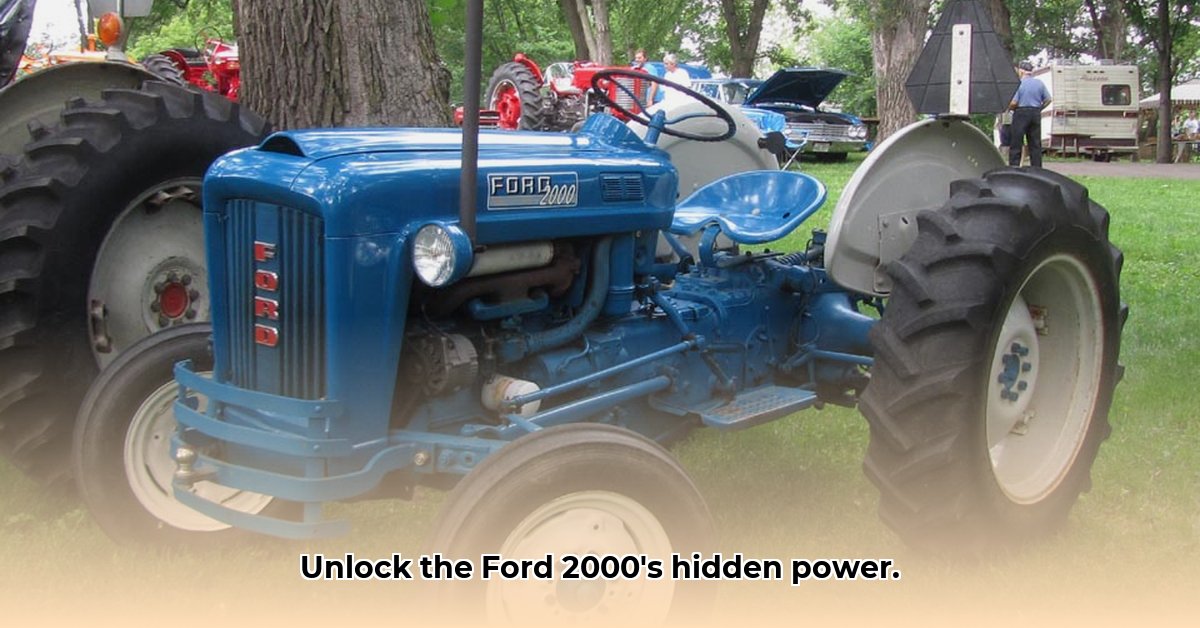
A Deep Dive into the Ford 2000 Tractor's History and Variations
The Ford 2000 tractor, produced from 1962 to 1975, remains a popular choice among collectors and enthusiasts. Its enduring appeal stems from a blend of robust design and adaptable capabilities. However, determining the precise specifications of a particular Ford 2000 can be complex due to variations across model years and inconsistencies in historical records. This comprehensive guide aims to clarify these details, offering a detailed comparative analysis to navigate the intricacies of this iconic workhorse. We'll explore engine variations, transmission options, and other key features, highlighting the challenges of piecing together a complete picture from often fragmented historical data. For more information on similar models, check out the Ford 4500 information.
Under the Hood: Engine Specifications and Variations
One of the most significant variations among Ford 2000 models lies in their engines. Early models (1962-1965) typically featured four-cylinder engines, with displacement estimates ranging from 2.2 to 2.4 liters depending on the source. This discrepancy likely reflects minor design adjustments or differences in measurement methodologies used. Around 1965, Ford transitioned to a three-cylinder, 2.6-liter engine, arguably a cost-effective change. This shift impacted the tractor's power output and performance characteristics. Precise horsepower figures remain elusive due to inconsistencies across historical documentation. This challenge is common when researching older agricultural equipment. What specific horsepower did your Ford 2000 boast? This is a question that may require further investigation based on the model's specific year and configuration.
Transmission Options: Adaptability for Diverse Agricultural Tasks
The Ford 2000 offered farmers a remarkable range of transmission choices, enhancing the tractor's versatility. Models equipped with four, six, eight, or even twelve speeds were available. This flexibility allowed farmers to choose a configuration perfectly suited to their unique needs. However, obtaining precise gear ratios for each transmission variant is surprisingly difficult. Many historical resources simply lack this level of detail, presenting a challenge to modern-day researchers and enthusiasts. This lack of comprehensive data is a common issue when studying older machinery. How did the diverse transmission options affect the Ford 2000’s operational efficiency across varying terrains and tasks? Further research is needed to fully answer this question.
Beyond the Engine and Transmission: Key Features and Data Gaps
The Ford 2000’s design included several notable features. Most models featured an open operator station, providing excellent visibility. Both gasoline and diesel engine options were offered, though the availability of each varied depending on factors such as model year and regional specifications. The availability of live and independent power take-offs (PTOs) further broadened the tractor's functionality. These PTOs, which power various implements, significantly expanded the machine's capabilities. However, detailed hydraulic system specifications—beyond basic flow and pressure data—remain scarce. This limited information underscores the difficulties in compiling a completely accurate specification guide for all Ford 2000 variations. This is a common problem with historical machinery records. How did the open operator station compare to later enclosed cabs in terms of operator comfort and fatigue? This is a relevant question for future research.
Reconciling Data Inconsistencies: A Critical Approach
The inconsistencies in Ford 2000 specifications found across various sources may stem from several factors: differences in testing methods, variations in record-keeping practices, and even simple reporting errors. This does not invalidate the existing data; rather, it highlights the complexities inherent in historical research. A critical approach is necessary, acknowledging the limitations of incomplete or inconsistent historical documentation. Our aim is not to definitively resolve every conflicting detail, but to present the available information transparently and accurately. What other factors might contribute to these inconsistencies in documented specifications, and how can we account for them in our analysis? This question requires careful study of the historical context.
Summary of Ford 2000 Specifications (Based on Available Information)
The following table summarizes the best available data, acknowledging the limitations of the available historical records.
| Feature | Generation 1 (1962-1965) | Generation 2 (1965-1975) | Notes |
|---|---|---|---|
| Engine | 4-cylinder, approximately 2.2-2.4 liters | 3-cylinder, 2.6 liters | Exact horsepower varies across sources; further research needed. |
| Fuel Type | Gasoline and Diesel (likely model-dependent) | Gasoline and Diesel (likely model-dependent) | Specific availability may depend on the year and other factors. |
| Transmission | 4, 6, 8-speed options | 4, 6, 8, 12-speed options | Precise gear ratios are not consistently documented across sources. |
| PTO | Live and Independent PTO (likely optional) | Live and Independent PTO (likely optional) | Availability might have differed based on model year and options. |
| Hydraulics | Limited detailed information available | Limited detailed information available | More research is needed to obtain more precise hydraulic details. |
Important Note: This table presents the most complete summary currently possible. However, significant data gaps remain. Further research may reveal a more complete understanding of the Ford 2000's specifications. The ongoing study of this iconic tractor continues to uncover new details.